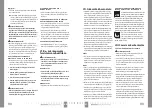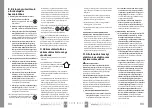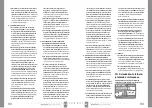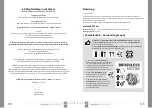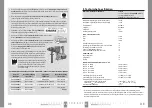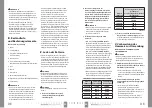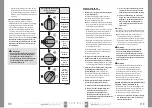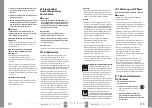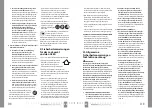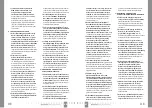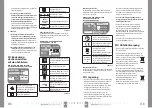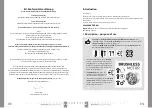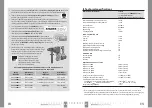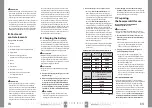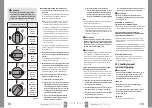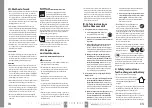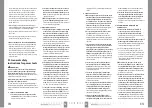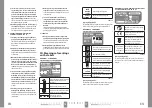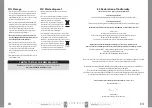
69
68
EN
EN
c) Connect the charger to an el. power source.
y
On charger
Extol® Premium 8891893
(model
with a charging current of 2.4 A), the charging
process is indicated by a green flashing diode with
a red lit diode, whilst a fully charged battery is indi-
cated by only a green lit indicator light.
On charger
Extol® Premium 8891892
(model
with a charging current of 4 A) the charging process
is indicated only by a red lit LED indicator light and
the fully charged process by only a green lit LED
indicator light. The battery charge level can be seen
by the number of lit LED indicator lights on the
battery, which are lit while the battery is charging.
The manufacturer reserves the right to change the
above-described indication of the charging process
/ charged state with respect to the possible changes
in the manufacturing process.
y
The charger will automatically stop charging when
the battery is fully charged. Battery overcharging
cannot occur.
APPROXIMATE BATTERY CHARGING TIMES
Battery
SHARE 20 V
4 A charger
Extol® 8891892
2.4 A charger
Extol® 8891893
8 000
mAh
120 min.
200 min.
6 000
mAh
90 min.
150 min.
5 000
mAh
65 min.
110 min.
4 000
mAh
60 min.
100 min.
2 000
mAh
30 min.
50 min.
Battery
SHARE 20 V
2
×
3.5 A charger Extol® 8891894
(for 2 batteries)
4
×
3.5 A charger Extol® 8891895
(for 4 batteries)
8 000
mAh
140 min.
6 000
mAh
105 min.
5 000
mAh
70 min.
4 000
mAh
60 min.
2 000
mAh
35 min.
Table 3
d) After charging, first disconnect the charger
from the el. power source
and then, after pressing
and holding down the button on the battery, slide the
battery out of the grooves in the charger.
V. Preparing
the hammer drill for use
INSTALLING THE FRONT HANDLE
AND DEPTH LIMIT STOP
•
ATTENTION
y
Never use the hammer drill without the front handle
installed. Loss of control over the tool may cause injuries.
1. Turn the handle to loosen the collar and seat
it into the grooves on the neck of the hammer
drill (see fig. 2A).
y
Prior to securing it in place, turn the handle to such
a position (fig. 2B) that the hammer drill is held
firmly, safely and comfortably during work.
2. Properly secure the handle in the required
position by turning it (fig. 2A).
y
For the purpose of measuring the depth of the
drilled hole, it is possible, while holding down the
lock button (fig. 1, position 3), to slide the depth
limit stop into the hole in the handle and to set it to
the required drilling depth.
The distance between the end of the depth gauge
and the end of the drill bit defines the depth (d) of
the drill hole, see fig. 3. To lock the depth limit stop
in place, release the depth limit stop lock button
(fig. 1, position 3). Check that the depth limit stop is
securely locked in position.
SETTING THE WORK MODE
y
Select the required work mode, i.e. impact drilling,
impactless drilling, chiselling mode or chisel orientation
adjustment function (Vario Lock system) by turning
the work mode selector dial (fig. 1, position 9) to the
symbol for the respective work mode as shown in table
4. To turn the work mode selector dial, it is necessary
to first unlock it by pressing the button on the selector
dial (fig. 1, position 10).
The selected work mode is
set when the work mode selector dial clicks into
the locked position of the selected work mode.
•
WARNING
y
Vibration and noise emissions during actual use of the
power tool may differ from the declared values depen-
ding on the method in which the tool is used, particu-
larly the type of workpiece that is being worked on.
y
It is necessary to determine the safety measurement for
the protection of the operator, which is based on the
assessment of exposure under real operating conditi-
ons (to include all the parts of the work cycle such as
time for which the power tool is turned off and when
running idle outside the time that it is in operation).
III. Parts and
control elements
Fig. 1, position-description
1) Drill bit
2) Keyless chuck head
3) Drill depth setting button via depth limit stop
4) Trigger switch
5) Rotation direction toggle button
in drill mode / for locking the trigger switch
6) Handle
7) Battery
8) Front handle
9) Work mode selector dial
10) Work mode selector dial release button
for setting the work mode
11) Depth limit stop
•
WARNING
y
Prior to preparing the power tool for use, carefully
read the entire user‘s manual and keep it with the
product so that the user can become acquainted with
it. If you lend or sell the product to somebody, include
this user‘s manual with it. Prevent this user‘s manual
from being damaged. The manufacturer takes no
responsibility for damages or injuries arising from use
that is in contradiction to this user‘s manual. Before
using this power tool, first acquaint yourself with all
the control elements and parts as well as how to turn
it off immediately in the event of a dangerous situation
arising. Before using, first check that all parts are firmly
attached and check that no part of the power tool, such
as for example safety protective elements, is damaged
or incorrectly installed, or missing. Likewise, check
the protective cover and DC connectors of the battery
and the charger, and also check that the power cord
or plug of the charger is not damaged. Do not use the
power tool, battery, charger with damaged or missing
parts and have this repaired or replaced at an autho-
rised service centre for the Extol® brand - see chapter
Servicing and maintenance, or the website address at
the introduction to this user‘s manual.
IV. Charging the battery
y
To check the battery power level, press the button on
the battery and based on the number of lit diodes and
the expected duration of operation of the hammer drill,
charge the battery if necessary. If the battery is fully char-
ged, all the LED diodes are lit. The battery can be charged
from any charge level without reducing its capacity.
•
ATTENTION
y
Only the batteries specified in table 1 may be used
for powering the hammer drill and they may only be
charged using the specified charger. Using different
chargers could result in a fire or explosion as a result of
inappropriate charging parameters.
•
ATTENTION
y
Charge the battery at an ambient temperature range
of 10°C-40°C.
a) First insert the battery into the grooves of the
supplied charger.
b) Before connecting the charger to the power sour
-
ce, check that the voltage in the power socket
corresponds to the range 220-240 V~50 Hz and
that the charger does not have a damaged power
cord (e.g. insulation), cover, charger connectors,
etc. Likewise, check the condition of the battery.
•
WARNING
y
If the charger or battery is damaged, do not use
it and have it replaced with an original in perfect
working order from the manufacturer.

